You searched for: ���haigui.in���������Returnees������returnees���������china���������������������������������
<< Previous | Displaying results 1-50 of 74 for "���haigui.in���������Returnees������returnees���������china���������������������������������" | Next >>
-
North-China Daily News photo showing Jewish Refugees in Shanghai, China
ArtifactAn illustration in the North-China Daily News following the arrival of a group of Jewish refugees in Shanghai, in Japanese-occupied China. August 24, 1941. [From the USHMM special exhibition Flight and Rescue.]
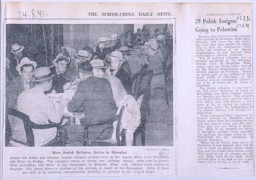
-

-
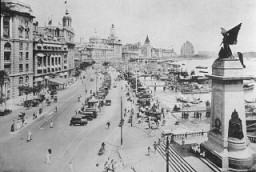
-
Polish Jewish Refugees in the Shanghai Ghetto, 1941–1945
ArticleDuring WWII, a few thousand Polish Jewish refugees lived in Japan. Learn more about the wartime relocation into and the conditions of the Shanghai ghetto.
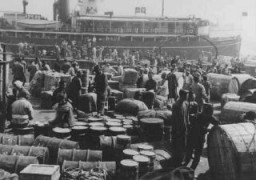
-
Arriving in Shanghai
PhotoGerman Jewish refugees disembark in the port of Shanghai, one of the few places without visa requirements. Shanghai, China, 1940.

-
Suitcase belonging to a Polish Jewish refugee (exterior)
ArtifactA few Polish Jewish refugees left Japan to join a small Jewish community in Harbin, Manchuria, in Japanese-occupied China. One of them carried this suitcase, covered with stickers from various shipping firms and hotels, on the journey to Harbin. China, 1940-1941. [From the USHMM special exhibition Flight and Rescue.]
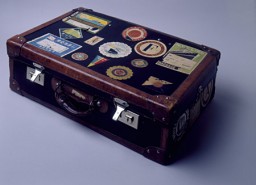
-
Suitcase belonging to a Polish-Jewish refugee
ArtifactA small group of Jewish refugees left Japan to join a small Jewish community in Harbin, Manchuria, in Japanese-occupied China. This image shows the interior of a leather suitcase carried by one of them to Harbin, China, 1940-1941. [From the USHMM special exhibition Flight and Rescue.]
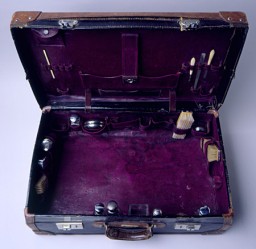
-
A Jewish refugee family prepares food
PhotoA Jewish refugee family prepares food with rations provided by the United Nations Relief and Rehabilitation Administration (UNRRA). Shanghai, China, 1946.
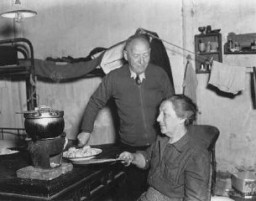
-
Aid to refugees in Shanghai
PhotoJewish refugees line up to receive food provided by the American Jewish Joint Distribution Committee (JDC) after the war. Shanghai, China, 1945-1946.
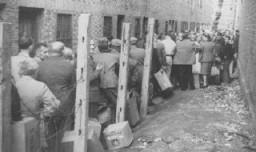
-
Austrian refugees arrive in Shanghai
PhotoAfter the Anschluss (German annexation of Austria), Austrian Jewish refugees disembark from the Italian steamship Conte Verde. Shanghai, China, December 14, 1938.
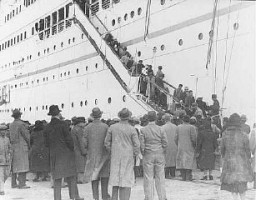
-
Matchbox cover with Japanese propaganda illustration
ArtifactDuring the war the Japanese flooded Shanghai with anti-American and anti-British propaganda, including this image from a matchbox cover. It depicts Japanese planes flying in formation over the U.S. and British flags, with the Japanese flag rising in triumph. Shanghai, China, between 1943 and 1945. [From the USHMM special exhibition Flight and Rescue.]
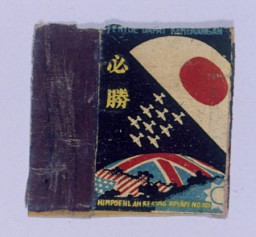
-
Matchbox cover with Japanese propaganda illustration
ArtifactDuring the war the Japanese flooded Shanghai with anti-American and anti-British propaganda, including this image from a matchbox cover. It depicts a Japanese tank rolling over the U.S. and British flags. Shanghai, China, between 1943 and 1945. [From the USHMM special exhibition Flight and Rescue.]
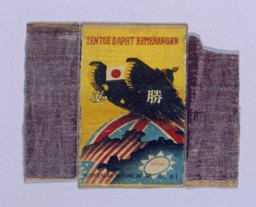
-
German Jewish refugee Erwin Eisfelder in Shanghai
PhotoGerman Jewish refugee Erwin Eisfelder stands outside Cafe Louis on Ward Road. The cafe was named in honor of his father. It was a popular gathering place for refugees in Shanghai during the war years. Shanghai, China, ca. 1944.
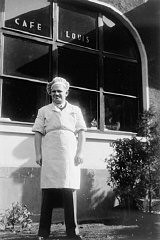
-
Sandals
ArtifactWooden sandals worn by a member of the Mir Yeshiva in Shanghai. [From the USHMM special exhibition Flight and Rescue.]
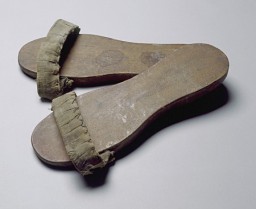
-
Zionist poster
ArtifactZionist poster produced by a Jewish organization in Shanghai commemorating the anniversary of Vladimir Jabotinsky's death, 1944.
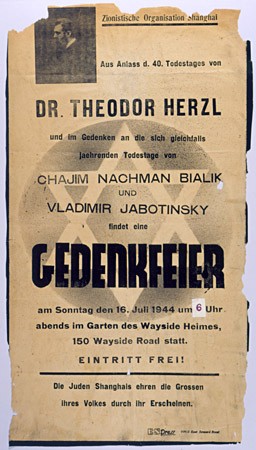
-
Passover Haggadah printed in Shanghai
ArtifactA Passover Haggadah published by rabbinical students in Shanghai in 1943. [From the USHMM special exhibition Flight and Rescue.]

-
Polish-language newspaper for refugees in Shanghai
DocumentPolish-language newspaper for refugees in Shanghai: Wiadomosci, "News for War Refugees in Shanghai." [From the USHMM special exhibition Flight and Rescue.]
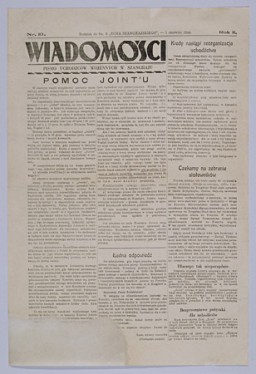
-
Our Life newspaper: Allied victory
DocumentNewspaper Our Life, for September 7, 1945, showing the headline "Long Live Allied Victory". [From the USHMM special exhibition Flight and Rescue.]
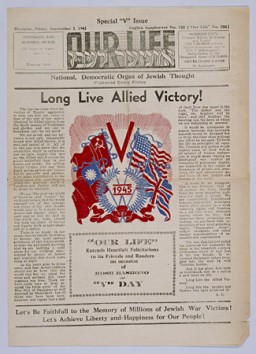
-
Yiddishe Shtime, December 1945
DocumentYiddishe Shtime fun Vaytn Mizrekh (Jewish Voice of the Far East), Shanghai, December 1945. Includes black border notice of 5,700,000 Jewish victims. [From the USHMM special exhibition Flight and Rescue.]
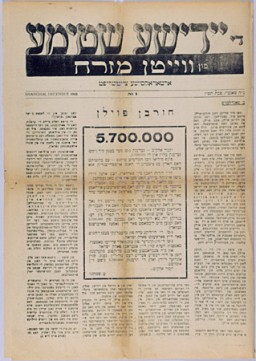
-
Rosh Hashanah card
ArtifactSorle and Shalomis Gorfinkel presented this card to their parents on the occasion of Rosh Hashanah 5704, the Jewish New Year 1943. The Gorfinkel family was part of the Mir Yeshiva community in Shanghai.

-
Refugee's writings
ArtifactYiddish writings of Josef Fiszman, a refugee writer from Warsaw. These are some Inside pages of a Fiszman's journal. The journal was written in Shanghai and is entitled "The Sun Never Shines At Night." [From the USHMM special exhibition Flight and Rescue.]
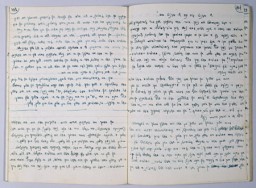
-
Scales used by refugees
ArtifactScale used by refugees Masza Swislocki and George Lieberfreund to weigh jars of artificial honey, which they manufactured and sold in the restricted area of Shanghai. [From the USHMM special exhibition Flight and Rescue.]
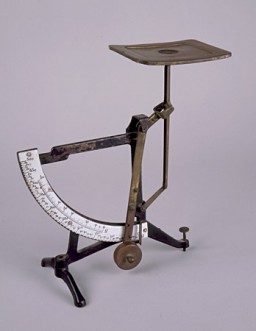
-
Rosh Hashanah card
ArtifactA Rosh Hashanah (Jewish New Year) greeting card. Sorle and Shalomis Gorfinkel presented this card to their parents on the occasion of Rosh Hashanah 5704, the Jewish New Year 1943. The Gorfinkel family was part of the Mir Yeshiva community in Shanghai.
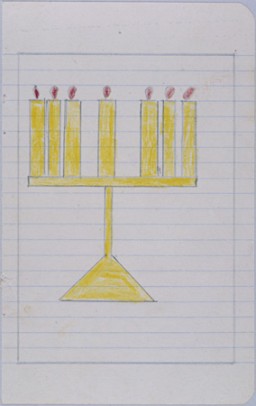
-
Sign from Shanghai Ghetto
ArtifactOne of many signs displayed along the Shanghai ghetto's boundaries: "Stateless Refugees are Prohibited to Pass Here without Permission". This plaque was removed by a refugee at the end of the war. [From the USHMM special exhibition Flight and Rescue.]
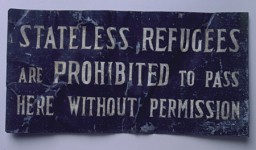
-
Proclamation of restricted zone in Shanghai for refugees
DocumentProclamation issued on February 18, 1943, by the Imperial Japanese Army and Nazy authorities establishing, for reasons of "military necessity," a "designated area" for "stateless refugees" in the Hongkew area of the International Settlement. [From the USHMM special exhibition Flight and Rescue.]

-
Silver kiddush cups of Caspary family
ArtifactGoblets used in Shanghai by the Caspary family for blessings (Kiddush) over wine on the Sabbath or Jewish holidays. The Orthodox Casparys ran a kosher restaurant frequented by yeshiva students from Poland. [From the USHMM special exhibition Flight and Rescue.]
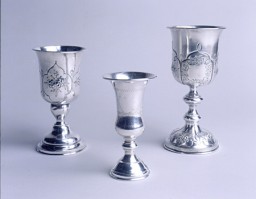
-
Mishneh Torah
ArtifactA page from the Mishneh Torah, one of many texts reprinted in Shanghai during the war. Yeshiva students spent part of each day listening to teachers lecture on the Talmud, the collection of ancient Rabbinic writings and commentaries composed of the Mishnah and the Gemara that form the basis of religious authority in Judaism. During the rest of the day, students paired up to review selections from the lecture. [From the USHMM special exhibition Flight and Rescue.]

-
Refugee's notebook
ArtifactNotebook of Josef Fiszman, a refugee writer from Warsaw. He sold articles to Jewish newspapers in Shanghai and Harbin but still needed help to live from the American Jewish Joint Distribution Committee. Writing in Yiddish, Fiszman rotated the notebook in order to write from right to left (the words "Note book" thus appear to be upside down in this image). [From the USHMM special exhibition Flight and Rescue.]
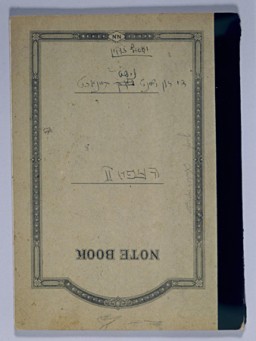
-
Walter Schnell
ID CardWalter was born to a Jewish family in the German town of Strehlen, 25 miles south of Breslau. His family's crystal business was prominent in the town for more than 100 years. Walter's parents sent him to Berlin in the mid-1920s to learn the porcelain trade. He returned to Strehlen in 1926 to help his family run the business. 1933-39: In 1937 Walter's family moved to Breslau. After the German pogroms of 1938 [Kristallnacht, Night of Broken Glass], he was deported to Buchenwald. When he arrived he was…

-
Armband for "Foreign Pao Chia Vigilance Corps Pao"
ArtifactIdentifying armband worn by Pao Chia member. In 1942 the Japanese in Shanghai established self-policing units, Pao Chia, composed of all men, foreigners and Chinese, aged 20 to 45. In the designated area, male refugees served several hours weekly in rotating shifts as guards for buildings and ghetto entrances where they examined passes. Despite the Japanese use of the Pao Chia to help police the ghetto, it was relatively easy to leave the "designated area," which was not walled in. Individuals who did so,…
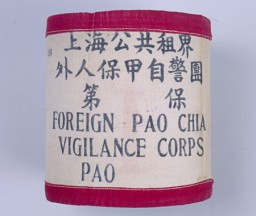
-
American propaganda announcement
DocumentAnnouncement dropped by American planes on Shanghai near the end of the war. [From the USHMM special exhibition Flight and Rescue.]
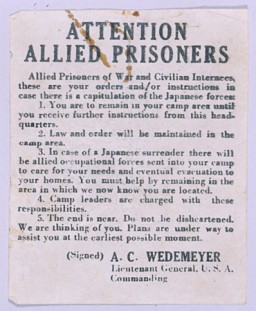
-
Woodblock print
ArtifactDavid Bloch, untitled woodblock print with watercolor, ca. 1945. Bloch, a German Jewish refugee, depicted typical shops in "Little Vienna," as Chusan Road in Hongkew became known. [From the USHMM special exhibition Flight and Rescue.]

-
Boy Scout badges
ArtifactBoy Scout handmade badges worn by German-Jewish refugee boys. British expatriates had transplanted the Boy Scouts to Shanghai before the refugees' arrival. Unlike most of the Polish Jewish refugees, German and Austrian Jews usually went to Shanghai as families, and enrollment in schools and youth organizations in the International Settlement grew rapidly. [From the USHMM special exhibition Flight and Rescue.]
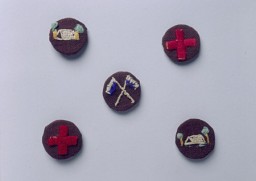
-
Portrait by refugee artist Yonia Fain
ArtifactPortrait of Semek Kushner, in pencil, by Yonia Fain. Kushner's father and brother were killed in Shanghai near the end of the war during an American air raid on Hongkew. [From the USHMM special exhibition Flight and Rescue.]
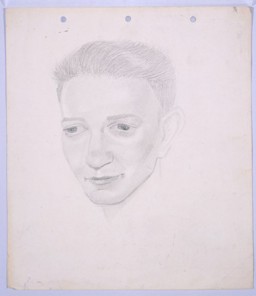
-
Matchbox cover with Japanese propaganda illustration
ArtifactDuring the war the Japanese flooded Shanghai with anti-American and anti-British propaganda, including this image from a matchbox cover. It depicts United States President Franklin D. Roosevelt--dressed in rags, on a raft in the ocean, and holding onto the U.S. flag--in the view of a Japanese submarine periscope. Shanghai, China, between 1943 and 1945. [From the USHMM special exhibition Flight and Rescue.]

-
Matchbox cover with Japanese propaganda illustration
ArtifactDuring the war the Japanese flooded Shanghai with anti-American and anti-British propaganda, including this image from a matchbox cover. It depicts a Japanese bomb landing in the United States heartland and knocking the stars off the U.S. flag. Shanghai, China, between 1943 and 1945. [From the USHMM special exhibition Flight and Rescue.]
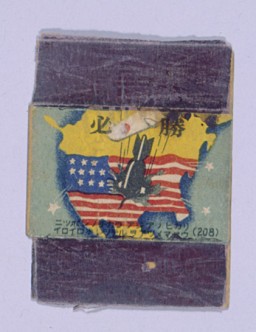
-
Playbill
ArtifactProgram for an evening performance sponsored by the Shanghai Jewish Club. The program included the play "The Day of His Return" and a concert of Jewish songs. On April 27, 1943, the day of this performance featuring Warsaw Jewish actress Raya Zomina, fierce fighting continued in the Warsaw ghetto between German troops and Jews who chose to resist Nazi efforts to liquidate the ghetto. Terrifying rumors about the Holocaust reached the Jewish refugees in Shanghai, but they did not receive reliable news or…
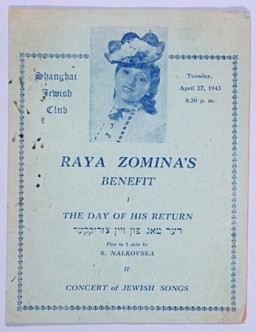
-
Fate of relatives
PhotoJewish refugees in Shanghai look for names of relatives and friends who may have survived the war. Awaiting repatriation, these displaced persons were under United Nations Relief and Rehabilitation Administration care. China, 1946.
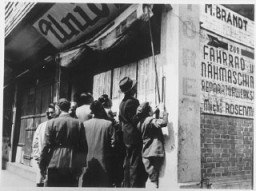
-
Pearl Harbor
ArticleJapan’s aerial attack on Pearl Harbor changed many Americans' attitudes toward involvement in WWII. Learn more about the events, facts, and background info.

-
Jewish refugees praying in Shanghai
PhotoJewish refugees at prayer in a synagogue. Shanghai, China, date uncertain.

-
Jewish refugees arrive in Shanghai
PhotoJewish refugees from Germany and Austria arrive at the port of Shanghai. China, 1938–1939.

-
World War II in the Pacific
ArticleThe United States declared war on Japan on December 8, 1941, following the attack on Pearl Harbor. Learn more about World War II in the Pacific.
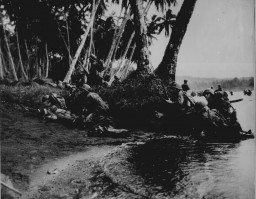
-
Nina Kaleska describes the formation of the ghettos in Grodno
Oral HistoryNina and her family were confined in a ghetto after the Germans entered Grodno in 1941. Her parents and then her sister perished after deportation to the Auschwitz concentration camp. Nina survived in the camp for two years. As the Soviet army advanced in 1945, Nina and other inmates from the camp were transferred first to the Ravensbrueck camp in Germany and then to the Retzof-am-Richlin camp. Nina was liberated in May 1945, during a forced march from the camp.
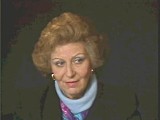
-
Matchbox cover with Japanese propaganda illustration
ArtifactDuring the war the Japanese flooded Shanghai with anti-American and anti-British propaganda, including this image from a matchbox cover. It depicts a Japanese plane dropping a bomb on the U.S. and British flags. Shanghai, China, between 1943 and 1945. [From the USHMM special exhibition Flight and Rescue.]
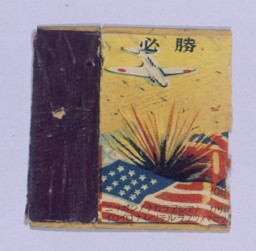
-
Jewish displaced persons about to be repatriated to Austria from Shanghai
PhotoGroup of Austrian Jewish displaced persons under the care of the United Nations Relief and Rehabilitation Administration who are to be repatriated to Austria from Shanghai, where they had sought refuge. From the Marine Falcon, they bid farewell to fellow refugees. Shanghai, China, 1946.
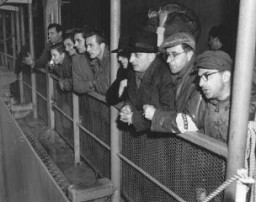
-
Polish citizenship certificate issued to Samuel Solc
DocumentPolish citizenship certificate issued to Samuel Solc on December 16, 1939, by the Britannic Majesty's Legation in Kovno, charged with representing Polish interests in Lithuania. Samuel decided to emigrate to Palestine in late 1939. His journey lasted over two years and took him through eight countries. Samuel arrived in Palestine on February 6, 1942, after stays in Lithuania; Kobe, Japan; Shanghai, China; and Bombay, India. [From the USHMM special exhibition Flight and Rescue.]
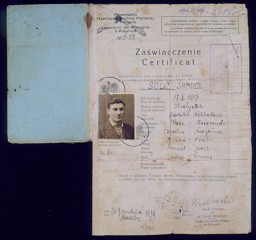
-
World War II: In Depth
ArticleGermany started World War II in Europe on September 1, 1939, by invading Poland. War would continue until 1945. Learn more about key events in the history of WWII.
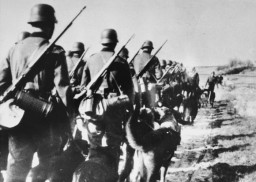
-
Polish Jews in Lithuania: Escape to Japan
ArticleAfter 1940, Polish refugees were pressured to leave Lithuania. Learn more about the diplomats that assisted them and their journey to Japan.
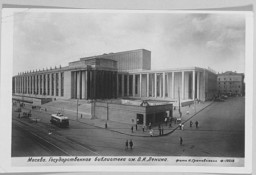
-
Axis Powers in World War II
ArticleThe three principal partners in the Axis alliance were Germany, Italy, and Japan. Learn more about the Axis powers in WW2.

-
Flight and Rescue
ArticleExplore the story of over 2,000 Polish Jewish refugees who fled east to escape war-torn Europe. They sought safety in such distant places as China and Japan.

